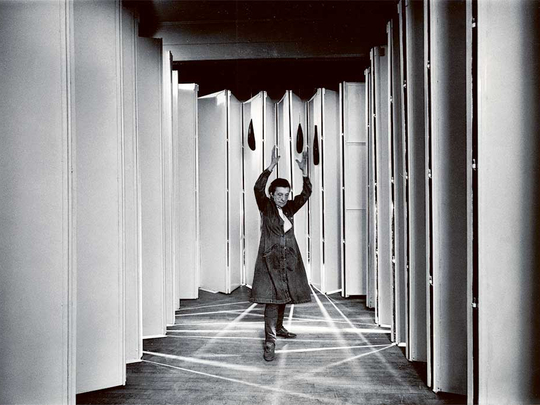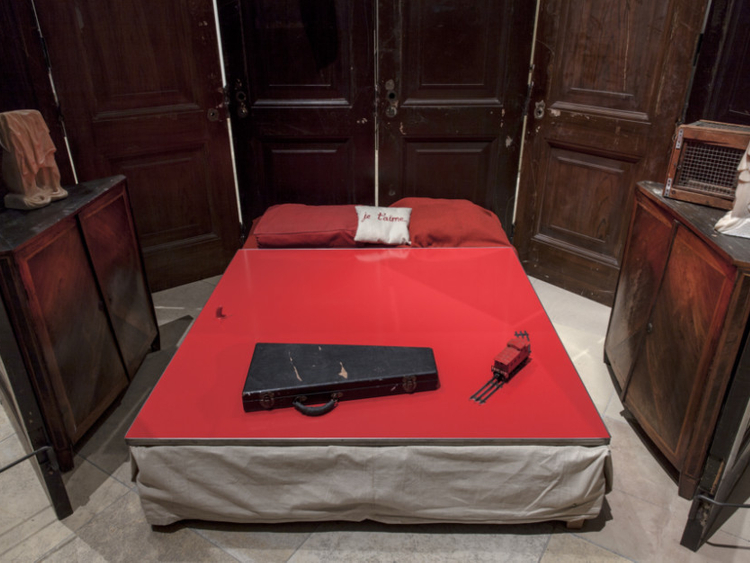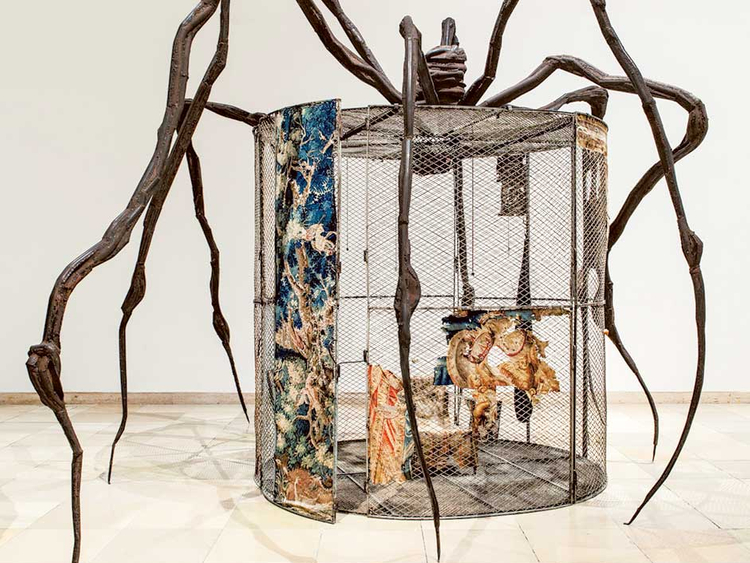
Outside Bilbao’s Guggenheim stands Louise Bourgeois’s most famous work: a nine-metre-tall bronze, marble and stainless-steel spider. Straddling the riverside walk so as to encourage you to walk beneath it, “Maman” is at once nightmarish and sublime, especially when lit up against the overcast Basque night sky. The night after I saw it, I had a bizarre dream about an army of male soldiers with very long legs, which smacked of some Freudian repression or other. Bourgeois — one of the most important “female artists” of the 20th century — would, I like to think, have approved.
The spider series was arguably Bourgeois’s most iconic work. Created in the 1990s, “Maman” was the first installation in Tate Modern’s newly built Turbine Hall. But, in Bilbao, six years after Bourgeois’s death, the Guggenheim has chosen to focus on her “Cells” series, in the largest presentation of it to date.
Red Room (Parents), detail; wood, metal, rubber, fabric, marble, glass and mirror, 1994
If you want to get into Bourgeois’s mind, the “Cells” are a good place to start. The 60-odd collection is challenging, even with my personal guide, Jerry Gorovoy, the artist’s friend and assistant, who is here to oversee the installation. These are dioramic, standalone sculptural forms using objects from Bourgeois’s childhood (plaster casts, text and drawings) and — of course — spiders, all within the confines of cell-like structures (usually penned in by doors or steel cages). Through them, she was able to analyse and express her memory, anxiety, fear of abandonment and pain.
“Cells” is her autobiography, her catharsis and her personal therapy. Despite working in almost every imaginable medium during her 70-year career (from the aforementioned drawing to sculpture and tapestry), Bourgeois almost always focused on the human form, whether supine, oversized, realistic or abstract. Sometimes it was the whole figure; sometimes just a foot. But all of her work was deeply personal.
Bourgeois only named these pieces “Cells” from 1991 onwards, which explains the inclusion of earlier work that seemed to inspire or influence the series, such as the famous “The Destruction of the Father” (1974), a grotesque rendering of her father’s body being torn apart and devoured in Peter Greenaway fashion. Combined, the discernible themes of self, motherhood and domesticity could explain why Bourgeois has become synonymous with the feminist art movement, taking on an almost ambassadorial role. You’d be forgiven for thinking she hated men, her father included.
In reality, says Gorovoy, she didn’t, and she actually preferred male to female company. But this is a narrative that rankled both Bourgeois and Gorovoy, a New Yorker who now, at 63, runs her foundation and oversees most of the global installations with a keen, instructive eye. “She was a strong feminist, but never called herself a ‘female artist’ or a ‘feminist artist’,” he says. “You wouldn’t be able to place her gender from looking at a lot of the work. To call her a ‘female artist’ or a ‘feminist artist’ is reductive. It was simply autobiographical — she was dealing with universal emotions: jealousy, rejection, and so on. These are pre-gender.”
It wasn’t that she explicitly rejected being defined in feminist terms (“Some of my works are, or try to be feminist, and others are not feminist,” she once said in an interview with the San Francisco Museum of Art). Rather, she adopted a contrary attitude towards critics eager to pigeonhole — or at least understand — her exclusively with those terms.
Bourgeois was born in Paris on Christmas Day in 1911. Her parents, Josephine and Louis, ran a tapestry gallery in the 6th arrondissement. At the end of the war, during the global pandemic, Bourgeois’s mother contracted influenza. During the course of the illness, Bourgeois’s father had affairs, particularly a long-term one with his daughter’s governess. It is thought this fear and anger towards her father stayed with Bourgeois, becoming a motif within her works, almost all of which were created in New York where she lived with her husband, art critic Robert Goldwater, after moving from Paris after their marriage in 1938.
Perhaps the enduring focus on Bourgeois’s relationship with her father and the patriarchy is the spider’s fault. “The spider is an ode to my mother,” Bourgeois once said. “She was my best friend. Like a spider, my mother was a weaver ... Like spiders, my mother was very clever.”
© The Easton Foundation/VEGAP, Madrid
The spider showed women as protectors: strong, maternal and powerful. However, from 1940 through to the 1990s, her work certainly touched on her paternal relationship which, though fractious, Gorovoy says was not as negative as critics have suggested.
“She loved her father, too, despite there being some antagonism. But too much has been made of his infidelity.” Indeed, Gorovoy thinks the affairs were minor. “People, critics, they need a narrative so as to understand her work — probably to explain the ever-changing complexity of her forms and material. This one stuck and, unfortunately, became the lens through which [critics] viewed and interpreted her. But it’s more about the world of her emotions ... and her three children, her husband. She wasn’t narcissistic.”
Another reason she found herself in feminist waters was the timing of her work. Just as she seemed to find her feet in the 1950s, the male-dominated genre of abstract expressionism exploded, making stars of male contemporaries such as Jackson Pollock and Mark Rothko, and overshadowing her sculptures. She began, through her work, to rebel against the patriarchy this represented. “She thought, for example, that the surrealists made women the object of their work, whereas she was trying to make women the subject,” says Gorovoy.
Bourgeois kept hundreds of diaries and letters. She spoke a great deal, internalising very little, and she used art as a way of expressing and investigating her own subconscious. “She was very anxious — a trait she thought she inherited from her mother,” says Gorovoy.
Anxiety is a continual thread through her work, from the arched figures (representative of hysteria) to the cupping cups she used to nurse her ailing mother, associated with her father’s infidelity. “She struggled with the burden of being a mother, a wife and an artist.”
That she spent 30-odd years in and out of psychoanalysis (Freudian, of course) is palpable, although it’s worth noting that she only started after the death of her father. In fact, a box of her writings has become a sort of ersatz student text on psychoanalysis, last seen in 2012 at an exhibition at The Freud Museum.
Writer and critic Tom Jeffreys explains: “An argument could be made that it was Bourgeois who kept alive art’s interest in Freud and showed that his writings were not only relevant to men. Where the surrealists focused on the more fantastic elements of the subconscious, Bourgeois played with his more subtle ideas of the uncanny (the unheimlich or un-homely).”
She was agoraphobic and often had insomnia, on occasions spending four consecutive days awake — by the end of which she would be in a manic state. She tried every pill, but some of them only made things worse. “If she worked, she was OK. If she didn’t, she became anxious ... and when she was anxious she would attack. She would smash things, destroy her work,” says Gorovoy. “Equally, if she didn’t like the colour of someone’s shirt, she would let them know.”
Being a woman making art about herself, it was perhaps unavoidable for the theme of gender to recur in Bourgeois’s work.
Bourgeois’s legacy is being thrust back into popular culture. Her home and the adjacent house in New York were opened as a foundation, with a scholars’ residency last month. And this month, continuing a fruitful relationship with Tate Modern, her work will appear in the new wing.
Bourgeois’s work continues to influence contemporary female artists, too. There is something Tracey Emin-like in her woven texts, for one. Jeffreys also cites Polly Morgan, Tessa Farmer and Adeline de Monseignat as direct influencees. “I’m not sure any of their work would be quite the same were it not for Bourgeois.”
Equally, her work has been aligned with that of male artists such as Robert Gober, as well as Matthew Barney’s story-like installations.
One of her final works, a series of hand-painted pictures titled “I Give Everything Away” (2010), lines three walls of the last room in the Guggenheim exhibition. Did she know she was going to die? “They talk about ‘leaving the nest’, but Bourgeois never talked about death.”
The sentiment is very final, discussing Bourgeois’s own departure from life, her family and her home as if she had, at last, found peace with herself and her own mortality. It feels very much like the work of a person whose gender, although immaterial to her work, is important for those trying to unpick her legacy — and understand what it is about her grand sculptures that speaks to both male and female artists today.
–Guardian News & Media Ltd
“Louise Bourgeois: Structures of Existence; The Cells” will run at Guggenheim Museum Bilbao until September 4.













